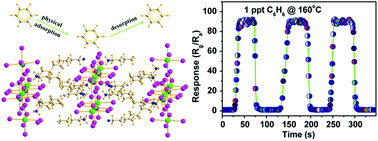Ppt-level benzene detection and gas sensing mechanism using (C4H9NH3)2PbI2Br2 organic–inorganic layered perovskite
Abstract
Benzene and formaldehyde are representatives of volatile organic compounds (VOCs), which are harmful to human beings due to their highly toxic and carcinogenic nature. So exploring efficient gas sensing materials to detect ultra-low concentration benzene is of utmost significance. In this paper, an organic–inorganic layered perovskite (C4H9NH3)2PbI2Br2 was synthesized through a facile solution method. And it was employed as a resistive gas sensing candidate to benzene, exhibiting ultrahigh response, fast response–recovery, good selectivity and repeatability for parts per trillion (ppt) level benzene detection at the optimum operation temperature (OOT) of 160 °C, with a response of 90.7 for 1 ppt benzene. In situ infrared analysis confirmed that the gas sensing mechanism is originated from the physical adsorption–desorption of benzene molecules onto the (C4H9NH3)2PbI2Br2 surface, the charge transfer model of which is different from that of conventional metal oxides. A promising application using such organic–inorganic hybrid perovskites for monitoring ultra-low concentration benzene might be interesting to researchers in the gas sensor field.



 Please wait while we load your content...
Please wait while we load your content...